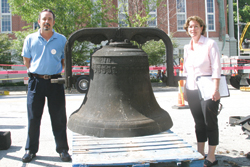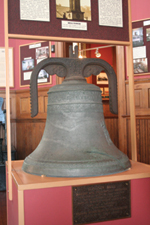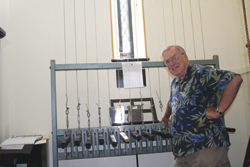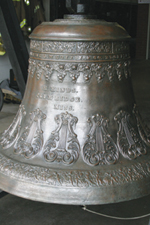



Chimes of the Times
Removal
of Courthouse bell
prompts interest in other bells
Madison
has several interesting bells
that have unique histories
By
Konnie McCollum
Staff Writer
(August 2009) – When the 3,118-pound bell was lowered
from atop the Jefferson County Courthouse and onto Madison’s Main
Street in the aftermath of the May 20 fire, dozens of people gathered
for several hours to take their first look at it. Some took photos of
the bell, which had never been seen by today’s generation.
The bell, forged in Cincinnati in 1864, was placed atop the courthouse
around 1869 and for many years rang on the hour. But for the past several
years, the clock mechanism had been broken and stored in the courthouse
basement.
The courthouse bell had gone silent and forgotten. Now that bell has
been placed into storage, awaiting the day when it can be cleaned and
possibly placed back into use.
The brief public appearance of the courthouse bell has since sparked
renewed interest by local historians in other bells around Madison.
For many decades, bells, such as the old courthouse treasure, have played
a major role in the social and communication network of Madison’s
citizens. These bells have alerted residents to fires, weddings, town
celebrations and holidays. They have tolled to honor fallen war heroes
and old friends. Many of those bells remain housed in churches, firehouses
and museums. Some have continued to ring and can be heard sounding their
message to those who stop and listen.
The history of bells extends back almost to the dawn of civilization,
when crude metallic objects were sounded to ward off evil spirits, to
alter the weather, or to mark festive occasions.
 |
|
Photos
by Don Ward Jefferson
County Commissioners |
At the Walnut Street Firehouse, Fire Co. No. 4, a bell
forged in Cincinnati in 1858 is still rung for monthly meetings and
to show respect at firefighters’ funerals. The bell has recently
been refurbished to remove layers of paint and grime.
“There were layers and layers of silver paint on the bell,”
said volunteer firefighter Frank Taff, who helped coordinate the refurbishing
project. “The bell was originally nickel plated, so instead of
trying to polish it, it may have been painted to look polished.”
The 36-inch diameter, 1,000-pound bell was cast by the Buckeye Bell
Foundry, the same Cincinnati foundry that cast the courthouse bell.
The Buckeye Foundry was originally the G.W. Coffin Bell Foundry but
was sold and operated by E.W. Vanduzen & C.T. Tift between 1866
and 1891. In 1891, the name was changed to The Vanduzen & Tift Co.,
and finally in 1894, changed to The E.W. Vanduzen Co., which operated
until it closed in 1951. It was one of the seven largest producers of
bronze bells in the United States during its heyday.
Unlike the courthouse bell that was cast in iron, the firehouse bell
is 100 percent bronze, which is a mixture of 80 percent copper and 20
percent tin.
“Many larger bells are cast of iron and do not have a good tone;
bells cast of bronze have great tone,” explained Taff. He said
the firehouse’s bell was originally cast as a musical bell for
Howard Hinds, a plantation owner in Mississippi. Hinds was murdered
in 1864 during an argument at his home. The bell was never delivered,
and by the start of the American Civil War, it was still at the Ohio
foundry. The Walnut Street firehouse bought the ornate bell for $710
in 1874.
“Had the bell been delivered to Mississippi during the war, it
would most likely have been melted down,” said Taff.
 |
|
Photo by Konnie McCollum The
Madison |
From 1874 to 1933, the bell hung in an ornate bell tower
at the firehouse but was then placed in a steel tower. In the early
1960s, it was moved to the “doghouse” on top of the firehouse,
where it was not viewable. Currently, it hangs on a special frame and
sits in the firehouse. Taff and other volunteer firefighters hope to
see it displayed for the community in a new cupola atop the firehouse.
“My hope is to see it get put back on the firehouse for the community
to view, but we would have to get specific donations for such a project.
We cannot use firefighting funds for it,” said Taff.
All of the Madison firehouses, except for No. 6 on the hilltop, still
have their historic bells, many of which can be seen hanging in their
towers. North Madison No. 5 Fire Co.’s bell is on permanent loan
from the Madison Consolidated School Corp.
According to research records at the Jefferson County Historical Society’s
Research Library, it was originally cast in 1889 by the Buckeye Foundry.
For many years, up to 1906, it was used by the Upper Seminary School,
where Eggleston Elementary is now located. It was stored at a glue factory
up until the firehouse acquired it in 1953.
Up until the early 1970s, the fire companies used a special code of
bell tones and ring numbers to alert firefighters and citizens to the
location of fires. “People would listen to the tone and count the
number of strikes to figure out where to go, “said Bob Thomas,
a research historian for the Jefferson County Historical Society’s
Research Library. “Each firehouse had its own bell tone, and people
knew which tone matched each firehouse.”
For decades, every day at 6 a.m. churchgoers at St. Mary’s, now
the Prince of Peace, would listen to the bells announce the start of
the day and the call to worship service.
The bells were installed in 1860 and remain today. Each of the four
bells at the church has a name, which was common for church bells. The
largest bell is St. Joseph, the second is St. Anne, the third is Marie
Angela, and the smallest bell is Gabriel.
At St. Michael the Archangel Church, now owned by Historic Madison Inc.,
there were also bells that announced the news of the church and community.
The largest of the St. Michael’s bells was named Gabriele Anne,
the second was Raphael Joachin, and the smallest was Joseph Patrick,
according to research documents. There is a fourth bell, but its name
was not mentioned in the documents.
Karl Eaglin, 61, remembers ringing the bells each morning at St. Mary’s
when he was in eighth grade. His father “volunteered” him
for the job.
“It was dark and scary up in the belfry. There were actually bats
up there and, of course, I was afraid of ghosts and the hunchback,”
he said, laughing. “But I thought I was so important.”
 |
|
Photo by Konnie McCollum Richard
Dickie plays the tubular |
He said there were notes attached to the ropes of each
bell with instructions on them as to how to ring them. “I rode
the ropes up and down as the bells rang,” he said.
Taff was also a young bell ringer for his Trinity United Methodist Church,
which still has its historic bell that reportedly came from a shipyard
and was originally used to summons workers to their jobs.
“When you are a kid, being in a church all alone when it is dark
is bad enough,” he recalled. “But the creaky steps leading
up to the belfry and the bats were really scary.”
He said he had constantly been cautioned against pulling the rope too
hard, but he “did it anyway, and flipped that bell over many times.”
“Then I had to climb up even higher and turn it back over,”
he said.
Richard Dickie is the church historian and official bell ringer for
Christ Episcopal Church. There is a unique bell system at the church
that was installed in 1905. There was an earlier bell, cast in 1853,
at the church, but it cracked on Easter Sunday in 1903. It was replaced
in 1905 with the large bell that still is used today for worship, weddings,
funerals and community events.
The set of 15 chiming bells was made by Walter Durfee and Co. of Providence,
R.I. According to Dickie, there are only six sets of the bells left
in the country, and Christ Episcopal Church’s set is the only one
that still works.
I’ve been ringing the bells for service for more than 10 years,”
said Dickie, who is also a church historian. During services at the
church and special occasions, Dickie uses levers attached to the tubular
chiming bells to ring out hymns.
“For years the bells weren’t used, and I began playing them
because I thought that was unfortunate,” he said.
 |
|
Photo by Konnie McCollum This
ornate bell was |
Schools throughout the community also used bells to ring
in the day for students and teachers and to alert them to any disasters,
community events and celebrations.
The bell tower at Historic Eleutherian College, located in Lancaster,
Ind., just north of Madison, still houses its original cast iron bell.
The bell, carried to the school by ox and cart, was forged by the J.A.
Kelley, Franklin Brass and Bell Foundry in Madison.
The college, with strong roots in abolition, was involved with the Underground
Railroad and served as the first stop leading north from Madison. Teachers
and students helped to hide fugitive slaves being educated at the college
before they moved further north.
Jae Breitweiser, president of Eleutherian College Inc., said that the
bell was rung for church, school and special village events.
“I have no doubt that the bell rung loud and long when the Civil
War ended,” she said.
Today, visitors to the historic college are encouraged to ring the bell.
“We noticed that every single time we let someone ring that bell,
they smile,” she laughed.
The Railroad Station Museum at the Jefferson County Historical Society
is home to an important bell in Madison’s history, the Station
Bell. Cast at the Garret Foundry of Cincinnati, it was originally installed
in the cupola of the newly constructed passenger depot in 1849 but then
spent almost a century traveling to various sites throughout the community.
The upper part of the bell is decorated with a frieze of allegorical
figures that represent the progress of the world in art, letters and
transportation. There is a crack in the bell that legend said was caused
in the early 1870s by longtime railroad employee William Smith. He was
ringing it one day when a passenger asked him why the bell was rung
a particular way. During the explanation, he accidentally gave the rope
an extra tug, which caused the bell to turn over. The impact of the
clapper caused it to crack.
For many years, the bell was rung half an hour and then five minutes
before the departure of passenger trains. The bell was the warning for
passengers to get to the station. In the early days of railroading,
the timetables were not a reliable means of learning when the trains
actually ran.
It was also used to sound the hour through the day and night, but that
practice was stopped when the company stopped placing a night watchman
at the depot.
In the 1880s, the bell was removed from the cupola and shipped east
to Richmond, Ind., to the estate of a railroad superintendent. It was
later displayed at the Richmond railroad station.
In 1916, the bell was returned to Madison and placed on display next
to the railroad station. By 1935, it was moved to City Hall on West
Street, where it was displayed on the front lawn until 1944, when it
went into storage at Clifty Falls State Park.
In 1953, the bell was placed on the Lanier Mansion lawn on an old millstone,
and in 1991 it was given by the state of Indiana to the Jefferson County
Historical Society.
An ornate bell stands at the corner of Lytle Park on West Street. It
was cast in Madison in 1851 by J. Garratt and Sons for the Lower Seminary
School, now the site of Lydia Middleton Elementary. It was moved to
the park in the 1960s.
Numerous other historic bells can be found high in lofty towers or tucked
away in dark belfries throughout the community, and they all have their
unique, yet connected stories about life as it used to be. These bells
add yet another layer to the rich historic fabric of a well-preserved
heritage.